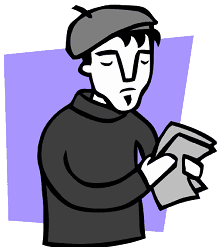Pattern of Stressed and Unstressed Syllables in Poetry Is Called
Rhythm in Poetry – You Can Scan, Man

As I explained in Rhythm in Poetry – The Basics , some syllables in English are " stressed " – pronounced louder or with more emphasis than others – while other syllables are "unstressed," meaning they are not emphasized. Knowing this, you can create patterns of stressed and unstressed syllables in your writing to create a rhythm in the words. Having rhythms in your poems make them more fun to recite and easier to remember.
To make it easy to spot the stressed and unstressed syllables in the examples I gave, I wrote them in UPPERCASE and lowercase letters, like this:
my PUPpy PUNCHED me IN the EYE.
The trouble with using this method is that it is awkward to write or type this way, and it makes the poem more difficult to read. Also, if you have a poem that is already printed on paper, you wouldn't want to have torewrite the entire thing just to show the rhythm.
Wouldn't it be better if could make marks to show the stressed and unstressed syllables? Indeed, there is such a system that is commonly used, and it's called "scansion" (pronounced "scan-shun"). The process of marking the stressed and unstressed syllables in a poem is called "scanning."
Scanning Poetry
The most common method of scanning a poem is to place marksabove the syllables to indicate whether they are stressed or unstressed. The mark for a stressed syllable is a slash ("/") and the mark for an unstressed syllable is a dash ("-"). Using these two simple symbols, we can mark lines of poetry to see their rhythms, like this:
- / - / - / - / My puppy punched me in the eye.
Now, just by looking at the dashes and slashes, you can easily see that this line of poetry has a repeating rhythm. The first syllable is unstressed, the second is stressed, the third is unstressed, and so on. In other words, the line alternates between stressed and unstressed syllables.
Counting Your Feet
In Rhythm in Poetry – The Basics , I also explained how poets typically count "feet" rather than syllables. A " foot " is a group of syllables that create the rhythm of the poem.
Most poetic feet contain a single stressed syllable, and one or two unstressed syllables. So you can usually count the number of feet in a line of poetry simply by counting the dashes after you scan it.
Knowing this, we can see that the line "My puppy punched me in the eye" contains four feet, and each foot is two syllables long. Let's take a look at another example.
- / - - / - I didn't go camping.
I hope you can see that this line hastwo feet (because there are two stressed syllables in the entire line), and each foot has three syllables (unstressed – stressed – unstressed). The first foot is "I didn't" and the second foot is "go camping." If we were to scan the entirestanza (a "stanza" is what we call a paragraph or verse of a poem), it would look like this:
- / - - / - I didn't go camping. - / - - / - I didn't go hiking. - / - - / - I didn't go fishing. - / - - / - I didn't go biking.
Notice that each of the four lines in this stanza have the exact same rhythm. That is, they have the same number of feet, and the same placement of stressed and unstressed syllables.
Now it's your turn to try your hand at scanning. Print out this page and use a pen or pencil write the scansion marks about each line in this stanza:
My mother said to do my chores,to dust the shelves and mop the floors,and wipe the walls and wind the clocks,and scoop the kitty's litter box.
When you are done scanning this stanza, here are a few questions to answer:
- How many feet are in each line?
- How many syllables are in each foot?
- Do all four lines have the same rhythm?
Hold your mouse over this line to see if you got the right answers.
Why Scan?
So, why would you want to learn how to scan poems? There are a number of ways in which scanning poems can be helpful when you are learning to write poetry.
- You can scan poems written by others to see what kinds of rhythms they use.
- You can scan your own poems to see if there are any mistakes in your rhythms (missing or extra syllables, misplaced stresses, etc.)
- Knowing how to scan poems can help you to experiment with different kinds of rhythms in your poems.
Now you know the basics of scansion. If you would like a little more practice, feel free to print out any of the poems on poetry4kids.com and add scan marks to them with a pen or pencil.
In the next Rhythm in Poetry lessons, I will introduce the different kinds of feet you will find in poems and show you how to use them in your own poems. Until then, happy scanning!
Next lesson: I Am the Iamb
Pattern of Stressed and Unstressed Syllables in Poetry Is Called
Source: https://www.poetry4kids.com/news/rhythm-in-poetry-you-can-scan-man/